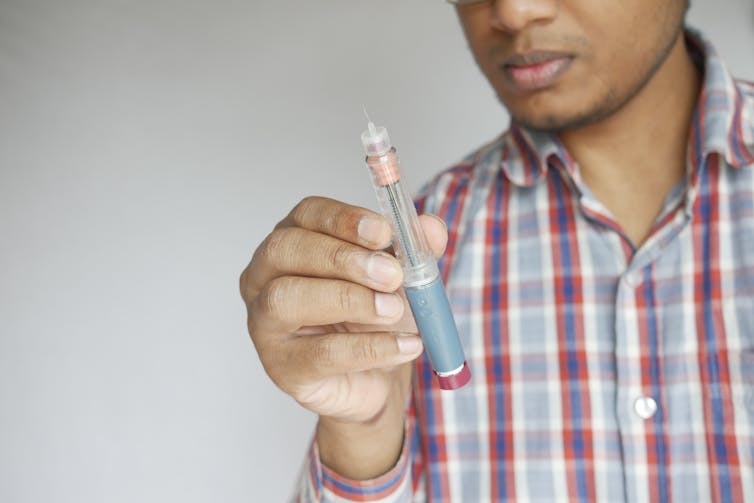
In 2021, there were 537 million adults living with diabetes, of which approximately 90 per cent had Type 2 diabetes. When someone has Type 2 diabetes, specialized cells within the pancreas known as “beta cells” produce insufficient amounts of insulin.
Insulin is a hormone that travels through the bloodstream and tells other cells to take excess sugar out of the blood and use this sugar as energy, making sure the body keeps doing everything it needs to.
Individuals with Type 2 diabetes are “insulin resistant,” meaning cells do not adequately recognize insulin. These individuals require more insulin than normal to regulate blood sugar levels. When beta cells fail to compensate for the increased insulin demand, blood sugar levels rise, adversely affecting organ function.
Globally, the South Asian community is composed of over two billion individuals. In Canada, 14.4 per cent of South Asians have Type 2 diabetes, the highest prevalence of any other ethnic group in the country.
As a member of the South Asian community, it is incredibly common for me (Lahari Basu) to learn that someone I know has been diagnosed with Type 2 diabetes. When I joined Dr. Jenny Bruin’s lab at Carleton University to study diabetes for my PhD, I was intrigued by this question: Why are South Asians disproportionately impacted by Type 2 diabetes?
That answer lies in a web of genetic, behavioural and cultural factors.
Genetic variants
In 2013, researchers confirmed that South Asians are particularly insulin resistant. Compared to Caucasians, South Asians had higher insulin concentrations in their blood after ingesting sugar. This means that South Asian individuals require more insulin to regulate their blood sugar levels, a characteristic of Type 2 diabetes.
There are numerous possible explanations for this, but genetic variants could be one culprit. Variation, or mutations, in genes can alter cell function. In the case of beta cells, genetic variants can lead to inappropriate levels of insulin secretion and insulin resistance.

It turns out that South Asians have acquired mutations in various genes required for proper beta cell function. They also have a higher prevalence of mutations in a gene called GRB14, resulting in increased insulin resistance.
Although not all South Asians have these mutations, a significant proportion do. There are also likely other gene variants that have yet to be uncovered in this population. These gene variants begin to paint an interesting picture of how genetic predisposition increases their risk of developing diabetes.
Physiological adaptations
Genetic variants only explain a small part of the increased insulin resistance in South Asian individuals. This observed insulin resistance may also have historical context.
South Asians have faced multiple famines throughout history. The recurrence of depleted food sources and malnutrition led to the development of a starvation adaptation. This adaptation allowed them to efficiently process food and store fat during times of abundance, providing an advantage during famine.
Now, with urbanization and migration, this trait can be detrimental to South Asians. The adaptation does not bode well in a world with increased access to high-fat foods. Combined with modern-day diets, this adaptation can result in increased fat storage and abdominal obesity in South Asian individuals, leading to greater risk of insulin resistance and diabetes.
Cultural differences
Food plays an important social role in South Asian culture. For as long as I can remember, big family dinners were integral to my lifestyle and cultural identity. For us, food is a way to communicate, to honour ancestors and to celebrate.
The staples of South Asian cuisine include white rice, flatbreads and potatoes, with most cooking being done in clarified butter. This diet is influenced from a time before refrigerators and food abundance, focusing on shelf-stable, self-preserving foods. Diets high in carbohydrates and fat have been linked to increased insulin resistance and decreased metabolism (the process of converting food into energy).
Culture-centred treatment

There is clearly a complex relationship between South Asian ethnicity and diabetes risk. The interplay of culture and genetics presents a unique challenge for this community. For many, unfamiliarity with diabetes may prevent them from getting the care they need.
Implementing treatment programs that focus on the culture of the patients can help approach diabetes management in a new light. Healthier versions of traditional foods, familiar languages and being cognizant of cultural barriers can help South Asians with diabetes understand the seriousness of the condition, their predisposition to it, and how to manage their symptoms.
A call for South Asian-centric research
As a South Asian woman studying diabetes, learning about this phenomenon opened my eyes to how little we know about ethnicity-specific diabetes risk. South Asians are severely underrepresented in clinical research. To truly understand the complex relationship between Type 2 diabetes and South Asians, it is vital to conduct clinical studies that specifically target this ethnic group.
A better scientific understanding of the link between South Asians and increased Type 2 diabetes and implementing culture-centred management programs can help alleviate the mystery and stigma behind this phenomenon.
Jennifer Bruin receives funding from the Canadian Institutes of Health Research (CIHR), Natural Sciences and Engineering Research Council of Canada (NSERC), and JDRF.
Lahari Basu ne travaille pas, ne conseille pas, ne possède pas de parts, ne reçoit pas de fonds d'une organisation qui pourrait tirer profit de cet article, et n'a déclaré aucune autre affiliation que son organisme de recherche.
This article was originally published on The Conversation. Read the original article.







